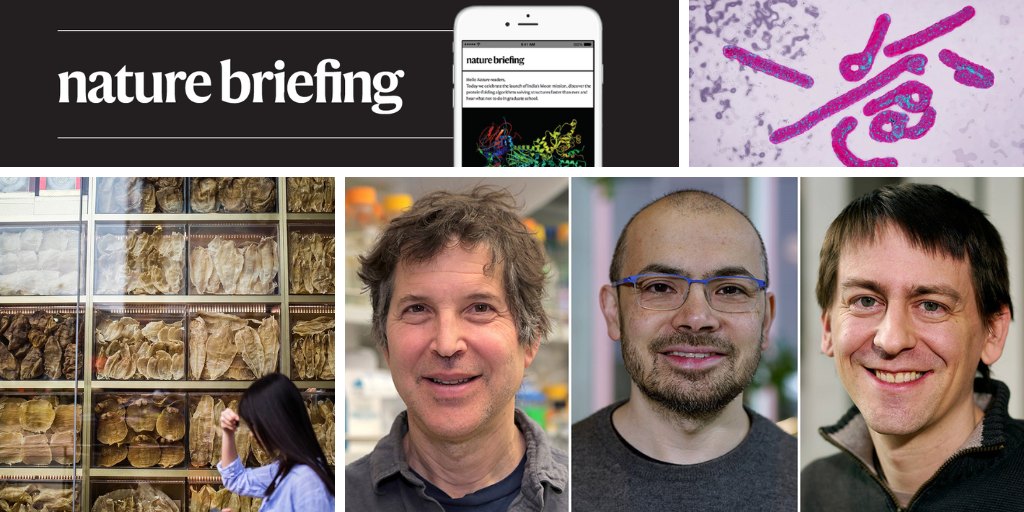Hello Nature readers, would you like to get this Briefing in your inbox free every day? Sign up here.
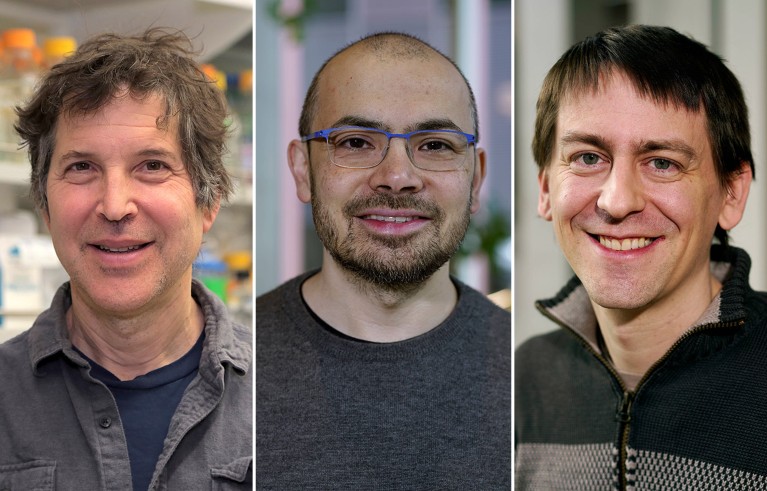
David Baker, Demis Hassabis and John Jumper (left to right) won the chemistry Nobel for developing computational tools that can predict and design protein structures.Credit: BBVA Foundation
One half of the Nobel Prize in Chemistry has been awarded to computer scientist Demis Hassabis, who co-founded the Google-owned artificial-intelligence company DeepMind, and theoretical chemist John Jumper, a DeepMind director and researcher. They won for leading the development of AlphaFold, an AI tool for predicting protein structures that has swiftly transformed biology. In 2021, DeepMind announced that it had used AlphaFold to predict the structure of nearly every protein made by humans, as well as the entire ‘proteomes’ of 20 other widely studied organisms.
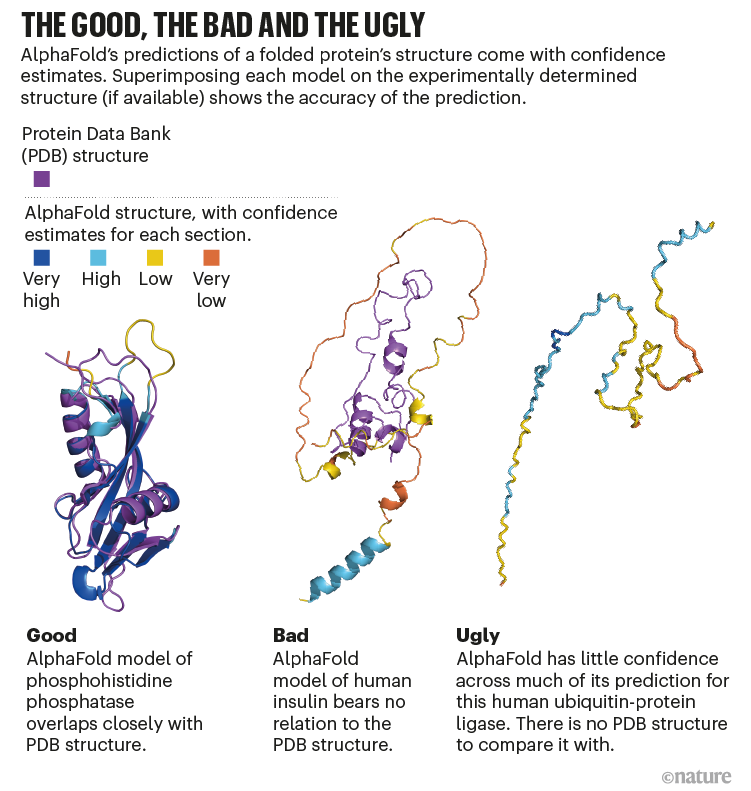
Images: J. M. Thornton et al. Nature Med. 27, 1666–1669 (2021).
Read more about AlphaFold and the AI protein-folding revolution in this feature from 2022. (17 min read) (Images: J. M. Thornton et al. Nature Med. 27, 1666–1669; 2021.)
Hassabis and Jumper share the prize with computational biophysicist David Baker, who led the development of another influential AI protein-design tool, RoseTTAFold. Baker won for his work not just predicting proteins that exist, but dreaming up new ones. In 2003, Baker’s research group created the first protein with an entirely novel structure, called Top7. His team is now using tools such as RoseTTAFold and AlphaFold to design proteins that do useful things, such as catalyse a particular chemical reaction, by specifying the amino acids responsible for the desired function and letting the AI dream up the rest.
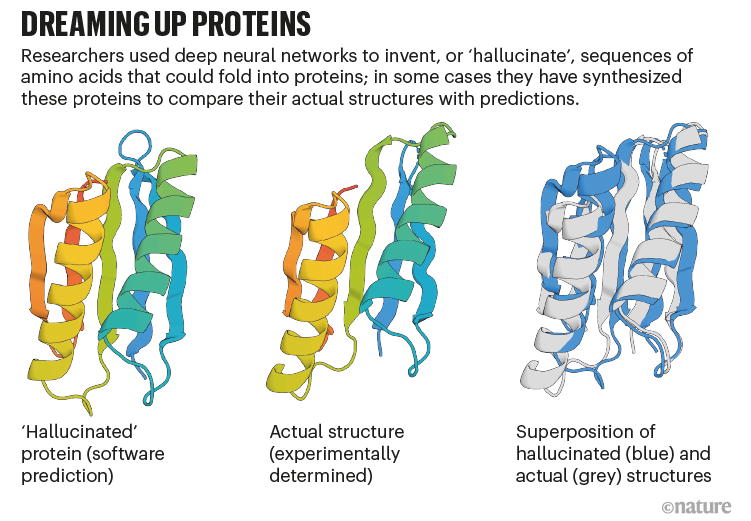
Images: Ref. 7
Rwanda is experiencing one of the biggest outbreaks of the Marburg virus ever documented. Scientists expect this outbreak to be contained, but warn that Marburg is on the rise, with no proven treatment. Outbreaks of the virus, a ‘cousin’ of the Ebola virus, usually start after a person encounters an infected fruit bat. Researchers say that environmental threats, such as climate change and deforestation, have made people more likely to encounter animals that can pass on infections. “The world really has to just be ready for that,” says emergency-medicine physician Adam Levine.
An elephant would be nothing without its trunk. Now, researchers have shown that its trunk would be nothing without its iconic wrinkles. Wrinkles appear as soon as the trunk develops during gestation — around 20 days in — and concentrate around a pivot point that allows the appendage to wrap around objects. Elephants also develop more wrinkles on one side of their trunks as they grow, depending on whether they’re ‘right-trunked’ or ‘left-trunked’.
Reference: Royal Society Open Science paper
A blunt and damning report on the state of the climate crisis concludes that “much of the very fabric of life on Earth is imperilled”. A selection of 35 planetary vital signs, such as greenhouse gas emissions and Antarctic ice loss, tell the tale: 25 of them have reached record levels this year. Most broke records last year, too. “It is staggering that, in a world where billions of people are already suffering from the impacts of climate change, fossil fuel emissions and deforestation rates are not slowing, but they are actually increasing,” says ecologist and co-author Thomas Crowther.
Reference: BioScience paper or read the plain-language summary by co-authors Thomas Newsom and William Ripple in The Conversation (5 min read)
Features & opinion
A surging market for ‘fish maw’ — dried swim bladders — in Papua New Guinea is a lifesaver for impoverished communities. But overfishing — particularly with gillnets, which indiscriminately capture many types of fish, dolphin and turtle — could ultimately damage the ecosystem and leave people even worse off. “There are very few controls and there is very little knowledge, I think, by the government fishery departments about the value, importance and potential threats of this,” says fisheries specialist Yvonne Sadovy. The consequence is “a sort of cowboy frontier”, whereby high prices push fishers to target species that “we hardly know anything about in terms of the science”.
It’s been 20 years since the launch of space-tourism venture Virgin Galactic. Billionaires seem to be popping up to space regularly — for example, entrepreneur Jared Isaacman, who was both spacewalker and bill-payer on a recent private SpaceX mission. But what about the rest of us? A couple of ultra-high-altitude balloon companies say they will soon be taking paying passengers on a stately trip into thin air at a discount price.
Image of the week
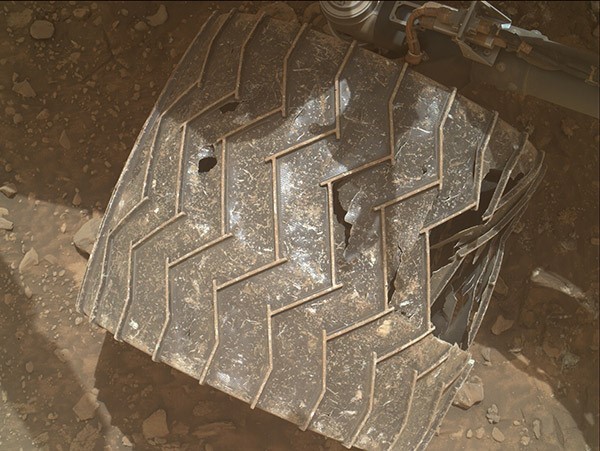
Considering that NASA’s Mars rover Curiosity has been on the red planet for over a decade, it’s understandable it’s showing signs of a little wear and tear. Here we see one of its six, well-worn wheels, the right middle, after 12 years of exploration. But despite taking a beating on Mars’s rocky surface, there’s plenty of life in the old rover yet. Curiosity captured this image with its Mars Hand Lens Imager (MAHLI) on the end of one of its robotic arms, on 22 September 2024. (Space.com | 3 min read) (Image credit: NASA/JPL-Caltech/MSSS)
Today I’ll be taking a break from the debate over whether the Physics Nobel-winning research is physics-y enough to visit the James Webb Space Telescope in Minecraft. Finally, we can frolic with a pickaxe on the iconic 18-segment primary mirror in a universe made completely of cubes.
As I ponder laureate John Hopfield’s assertion that “physics [is] not subject matter… physics [is] a point of view”, why not send me your feedback on this newsletter? Your e-mails are always welcome at [email protected].
Thanks for reading,
Flora Graham, senior editor, Nature Briefing
With contributions by Jacob Smith
Want more? Sign up to our other free Nature Briefing newsletters:
• Nature Briefing: Careers — insights, advice and award-winning journalism to help you optimize your working life
• Nature Briefing: Microbiology — the most abundant living entities on our planet — microorganisms — and the role they play in health, the environment and food systems.
• Nature Briefing: Anthropocene — climate change, biodiversity, sustainability and geoengineering
• Nature Briefing: AI & Robotics — 100% written by humans, of course
• Nature Briefing: Cancer — a weekly newsletter written with cancer researchers in mind
• Nature Briefing: Translational Research — covers biotechnology, drug discovery and pharma


